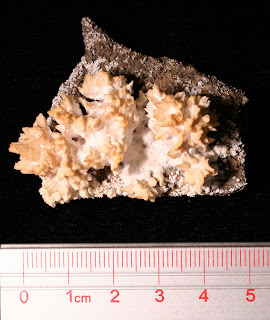Several weeks passed when I noticed something interesting in the container, formations of white crystals were forming. As it turns out a chemical reaction was taking place, one in which the limestone samples (calcium carbonate) were interacting with the vinegar (acetic acid) to form water, carbon dioxide, and calcium acetate (calcium salt). The carbon dioxide floated off into the atmosphere, the water eventually evaporated, which just left the limestone and crystallized calcium acetate.
Limestone + Vinegar = Calcium Salt + Water + Carbon Dioxide
CaCO3 + 2CH3COOH = Ca(CH3COO)2 + H2O + CO2
The calcium acetate formed a texture and color that reminded me of the layer of meringue that one finds on lemon pies.
 |
| Lemon Meringue Pie - photo by Renee Comet (1994) - wikipedia.org |







